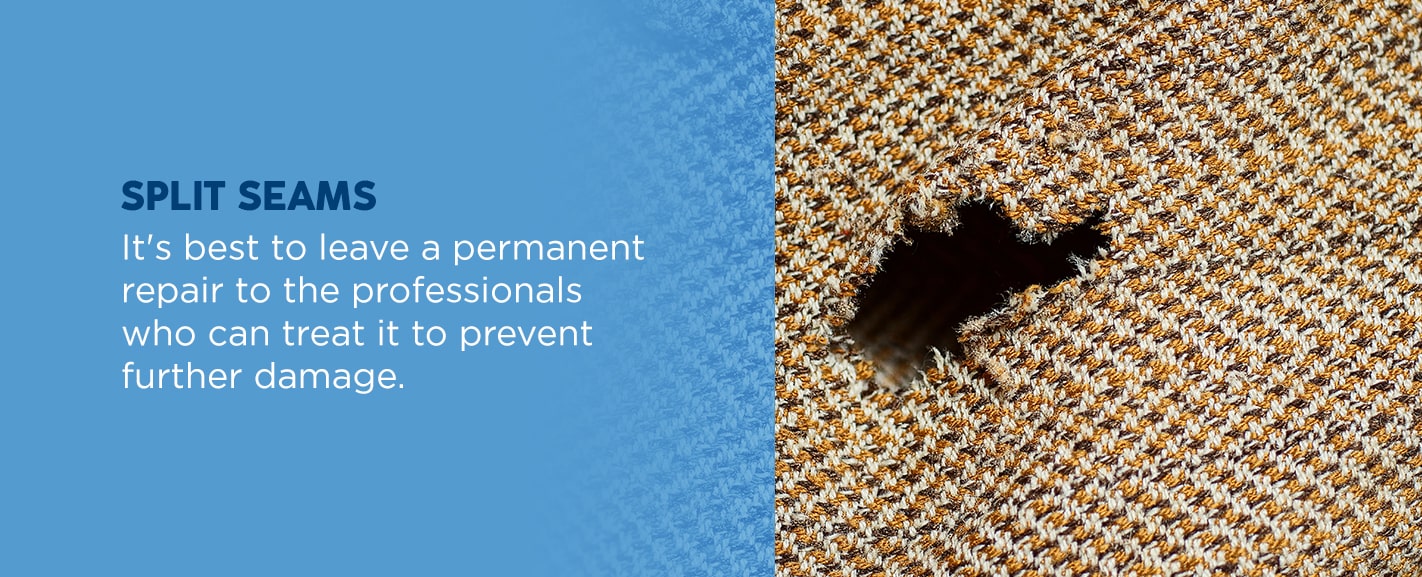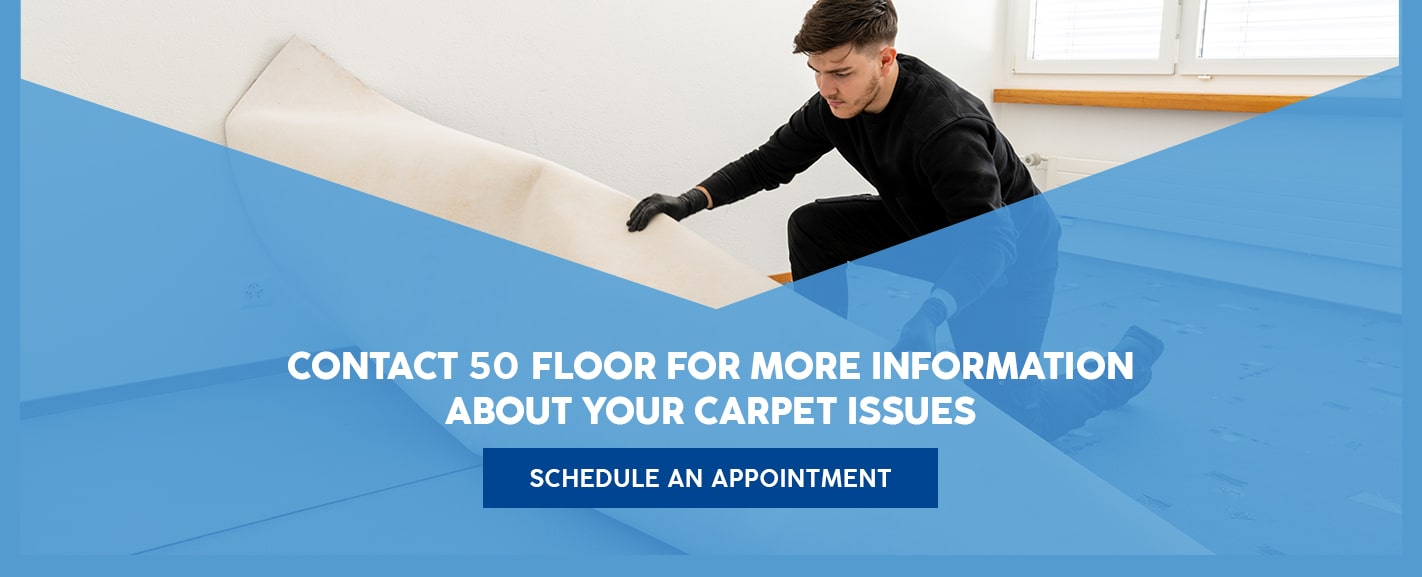

Carpet is a soft, comfortable flooring material that comes in various colors and textures to meet your lifestyle needs. Due to improper installation or excessive wear over time, you may discover that your flooring needs a little extra maintenance. Explore these common carpet problems to know what to do in case it starts happening to your floors.
1. Carpet Buckling
You may notice a ripple or bulge in your carpeting, as if something underneath the floor forced it upward. Moisture exposure usually causes carpet buckling, including getting your carpet professionally cleaned. Usually, the ripples disappear when the carpet is completely dry, after the fibers have shrunk again. However, you may also notice your carpet starting to ripple from:
- Dragging heavy items across the carpet
- The wrong carpet padding
- Humidity in the room
- Heavy traffic
- Improper steam cleaning
- Incorrect installation
You can try to prevent carpet buckling by lowering the humidity in your room. Keep in mind that if you live in a humid or damp environment where it’s hard to control the moisture in the air, you may have to get your carpet stretched by a professional. In some cases, you may even need to have a new carpet installed. Consult a flooring specialist about your next steps.
2. Carpet Fading
Carpeting comes in many different colors, but its appearance might fade over time. You may notice one of these two different types of color fading.
- Discoloration: Your carpet may lose its color when exposed to direct sunlight or harsh cleaning chemicals. When cleaning your carpet, you should read the product’s label and test a little bit of it on a hidden part of the carpet to prevent discoloration. You may also want to get your carpet professionally cleaned instead of trying to do it yourself. If your carpet’s color has already faded, consult a professional about getting it re-dyed or replaced.
- Shading: You may also notice shading on your deep-pile carpet when the fibers are in different directions. You can treat carpet shading by vacuuming your carpet so all the carpet fibers face the same direction. If the problem persists, you may have to consult a professional to rule out other issues.
3. Carpet Shedding
When you first get your carpet installed, it’s normal for fibers to shed. You’ll notice this phenomenon most when you’re vacuuming up some loose carpet fibers, but you may also see balls of carpet on the floor. The problem should stop on its own within a few months after installation.
If your older carpet sheds, it could be from the following:
- The type of fibers it has
- Improper maintenance
- Other carpet issues
You can prevent and treat carpet shedding by thoroughly and safely vacuuming your floors. Some carpeting fibers are more delicate than others, so it’s necessary to use the right vacuum setting to maintain their integrity. You may also want to get your floors professionally cleaned.
Schedule a Free In-Home Consultation
4. Carpet Matting and Crushing
Over time, your luxurious plush carpet may look flat or crushed. Carpet matting is when the carpet fibers lose their thickness. You may notice this carpet issue as a result of:
- Heavy traffic
- Improper vacuuming
- Incorrect cleaning
If you’re trying to clean the floors yourself, read the manufacturer’s instructions for care. You may also want to replace your carpet with a material that’s more resistant to matting. When choosing new flooring, you may want to pick one that can withstand heavy traffic. If you have this issue with your existing carpet, consult a professional about getting it cleaned to improve its appearance.
5. Carpet Raveling
Your carpet’s fibers may start to fray and unravel over time. This damage occurs when the carpet fibers fall out or get untangled, twisted or loosened. You may notice it in a small, inconspicuous area, or the unraveling might have taken over a large portion of your carpeting. This issue happens to carpet because of:
- Old age
- High traffic
- Improper cleaning
- Moving furniture across it
- Incorrect installation
If you notice significant damage, you may have to get your carpet replaced. You can reach out to your flooring specialist to repair it if your floors are relatively new. You can prevent carpet unraveling by maintaining it according to the manufacturer’s instructions. It’s also helpful to get your carpet professionally cleaned and installed.
6. Split Seams


Professionals install your wall-to-wall carpeting in different pieces and connect them at the seams. You may notice your carpeting seams start to split, resulting in the edges coming apart and fraying. This carpet issue may occur for one of the following reasons:
- Heavy traffic
- Improper installation
- Poor-quality carpet
You can temporarily fix this issue by gluing or taping down the frayed edges. It’s best to leave a permanent repair to the professionals who can treat it to prevent further damage. You may also want to upgrade to a higher-quality carpet to keep this issue from happening in the future.
7. Indentations
Carpeting tends to get indentation marks from heavy furniture. If you have heavy furniture in your carpeted room, you can prevent permanent indentations with the following methods:
- Put a coaster or glider under each piece of furniture’s legs.
- Move the furniture around every once in a while.
- Vacuum your floors often to restore your fibers’ appearance.
If you already have indentations on your carpeting, try putting ice cubes in the depressions or iron your carpet to make it look new. Getting your floor professionally steamed can also help with stubborn indentations.
8. Stains
Even when you clean your carpeting routinely, you might notice stains from food crumbs or liquid spills. Recurring stains on your carpet may be a result of one of the following:
- Pet activity
- Moisture retention from the padding underneath
- Improper cleaning
Besides your regular carpet cleaning routine, you can also clean up stains with white vinegar, mild detergent and warm water. After putting on the solution, make sure you rub the stain continuously. Rinse the area and wait for it to dry. When it’s dry, clean up any loose debris with a vacuum cleaner.
You can prevent stains by investing in a carpet color that doesn’t show dirt. You’ll still need to clean your carpet regularly, but you won’t have to be as concerned about having guests over.
9. Wear
Besides damage, your carpet may start to lose its density over time. You can prevent carpet wear by taking care of it through proper cleaning and maintenance methods. Along with vacuuming it, you may want to get it professionally cleaned about once a year to restore its appearance. If you notice excessive wear, you may be able to get it replaced if your carpet is under warranty. Consult a flooring specialist about repairing or replacing your worn-out carpet.
Contact 50Floor for More Information About Your Carpet Issues
Whether you need new carpeting or want more information about carpet care, you can connect with our flooring specialists at 50Floor. We offer different types of carpet and will help you find the right one for your property. Reach out to us online or call 877-50-FLOOR.




